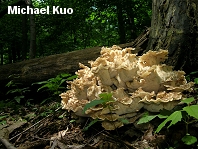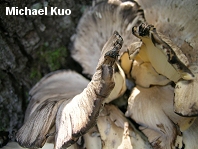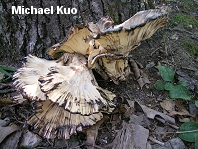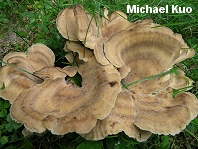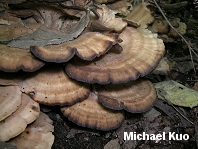| Major Groups > Polypores > Stemmed, Pale-Fleshed > Meripilus sumstinei |

|
Meripilus sumstinei [ Basidiomycetes > Polyporales > Meripilaceae > Meripilus . . . ] by Michael Kuo With similar mushrooms known as the "hen of the woods" and the "chicken of the woods," I think Meripilus sumstinei should be known as the "rooster of the woods," just to add to the confusion--which is already fairly rampant, to judge from the hen-chicken, chicken-hen e-mails I receive confusing the two officially named-for-fowl mushrooms. Actually, the chicken of the woods isn't very similar to Meripilus sumstinei in appearance (though I have heard mycological rumors that it is similar, genetically), since it is bright yellow or orange. The hen of the woods, however, is often mistaken for the "rooster," since both species are brownish by maturity and both fruit near the bases of hardwoods in large clusters. But while the hen of the woods has small caps and a pore surface that is initially lavender grayish, Meripilus sumstinei has larger caps and its pore surface, when young, is pure white. Additionally, Meripilus sumstinei bruises and discolors black and features much tinier pores. North American field guides usually treat this species as "Meripilus giganteus," but that name refers to a strictly European species; see Larsen and Lombard (1988) for details. Description: Ecology: Parasitic on living oaks and other hardwoods (also reported on Douglas-fir) and saprobic on the deadwood of hardwoods; causing a white rot; growing in large clusters of rosettes near the bases of trees; often reappearing in the same place in subsequent years; summer and fall; widely distributed east of the Rocky Mountains, and occasionally reported in the west. Fruiting Body: Up to 30 cm broad or more; composed of multiple caps sharing a branched, stemlike base. Caps: 5-20 cm across; fan-shaped; finely velvety or bald; whitish becoming brownish with age; often radially streaked and concentrically zoned; the margin thin, bruising and aging black. Pore Surface: Whitish, becoming dirty tan; bruising dark brown to black when fresh; with 6-8 round to angular pores per mm; tubes to 8 mm deep. Stem: Whitish, becoming brown to blackish with age; tough; short; often off-center. Flesh: Firm; white; somewhat stringy. Odor and Taste: Mild; pleasant. Chemical Reactions: KOH negative on flesh. Spore Print: White. Microscopic Features: Spores 5-5.5 x 4.5-5 µ; smooth; subglobose; inamyloid; with a distinct apiculus. Fusoid cystidioles present but not projecting. Hyphal system monomitic. Clamp connections absent throughout. REFERENCES: (Murrill, 1904) Larsen & Lombard, 1988. (Saccardo, 1905; Overholts, 1953; Smith & Weber, 1985; Gilbertson & Ryvarden, 1987; Phillips, 1991/2005; Lincoff, 1992; Horn, Kay & Abel, 1993; Miller & Miller, 2006; Binion et al., 2008.) Herb. Kuo 08260601, 07130809. This site contains no information about the edibility or toxicity of mushrooms. |
© MushroomExpert.Com |
|
Cite this page as: Kuo, M. (2010, March). Meripilus sumstinei. Retrieved from the MushroomExpert.Com Web site: http://www.mushroomexpert.com/meripilus_sumstinei.html |
